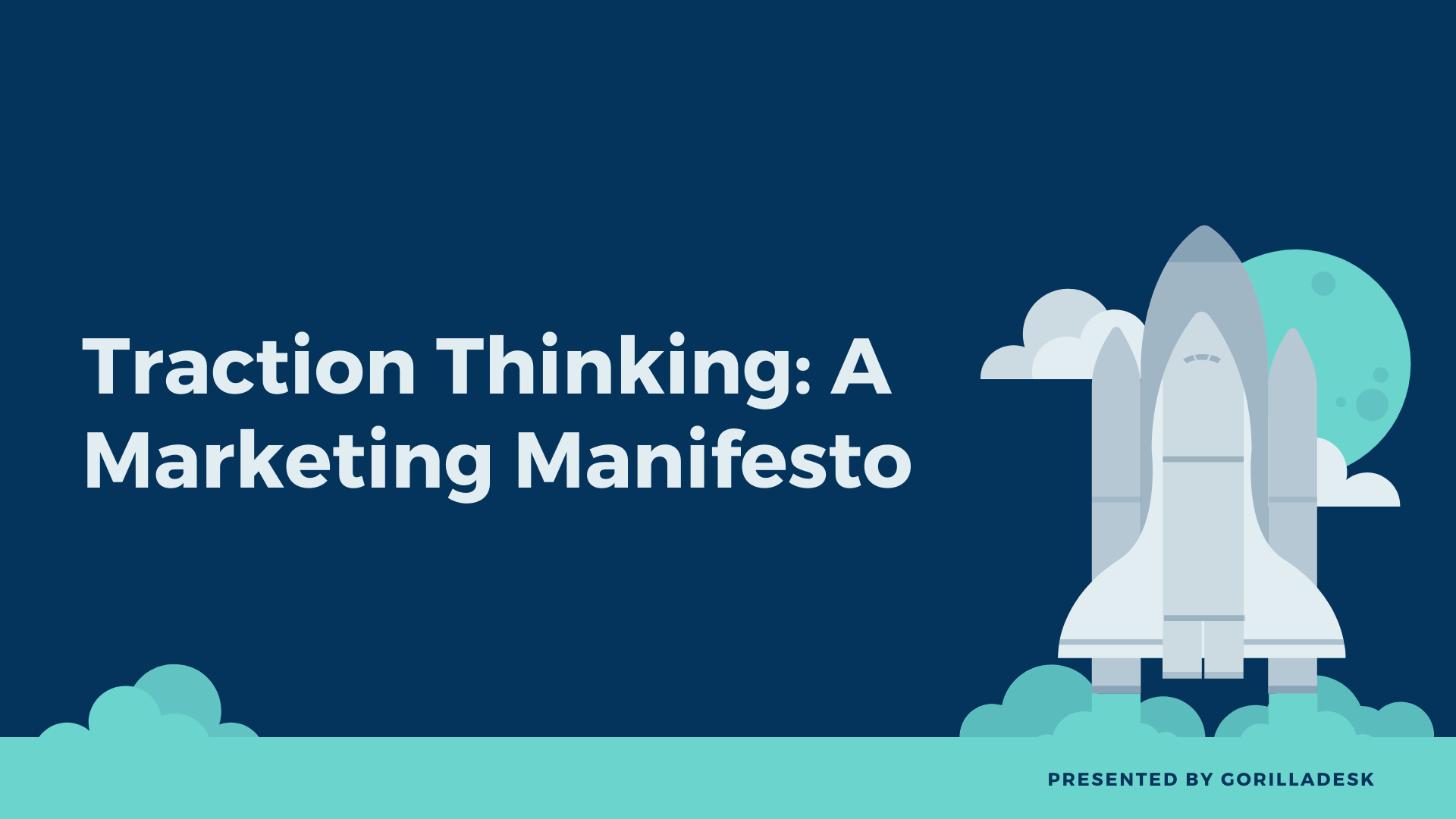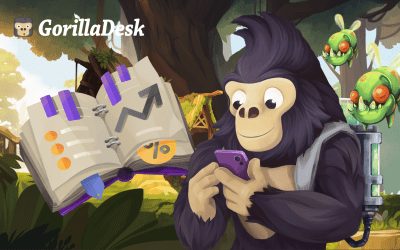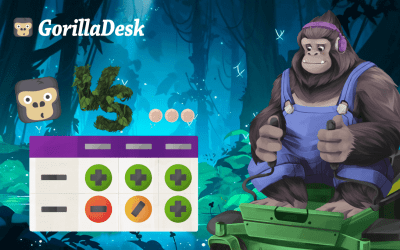Traction Thinking: A Marketing Manifesto
Chris Moreschi

Now, you may be wondering… Where do I even begin? How much time and/or money should I be spending? Or dow do I know if my marketing efforts are working (or not)?
Don’t worry, this series will answer those questions and so much more, because our number one goal is to re-shape your beliefs around marketing. Once you understand what marketing is and how marketing works, you will be fully prepared to implement the strategies and tactics we cover over the next few months.
But if you don’t develop a marketing mindset, you will remain stuck in a vicious cycle, jumping from one marketing channel to the next, with little regard for opportunity cost. Does this sound like you?
If you’re nodding your head right now, you’re going to love what’s next. Let’s begin…
Spend 50% of Your Time on Marketing
If you run a local service business, chances are you provide a solid service. Almost every company that’s just getting by has a good enough service offering. But what most struggling businesses don’t have is enough customers. Every month feels like you’re just getting by.
A common story goes like this… A soon-to-be business owner gets his or her start by working for another company. They spend a few years learning everything about the industry but eventually grow tired of working for someone else. Something about the company rubs them the wrong way, and they feel like they can do things better, so they decide to start their own business.
The problem is, though, that sooner or later, they realize customers aren’t flocking to them like they thought they would, and then the pressure sinks in. You see, you can do everything else right, but if you’re unable to acquire customers predictably and consistently, you have a MASSIVE problem.
So what is the solution?
You need to focus 50% of your efforts on marketing from day one. And if your business has been around for a few years, well, you’re going to want to start marketing as soon as possible so you can avoid (or dig yourself out) all of these traps…
- The “No Market” Trap: you offer a great service, but are unable to figure out a viable business model. The numbers just don’t make sense. An example of this is when potential customers think your prices are too high, so you begrudgingly lower them. The problem is, at this new price point, you are unable to meet payroll and pay your bills.
- The “Small Market” Trap: you offer a great service, but there aren’t enough customers to keep the lights on. Either your business model is too niche (EXAMPLE), or your service area is too small/underpopulated. There aren’t obvious ways to expand.
- The “Hard to Reach Market” Trap: you offer a great service, but reaching customers is cost-prohibitive. Advertising either costs you and arm-and-leg OR you have to hire an expensive sales force to close deals. Here, you have no problem acquiring customers, but spending time and/or money on advertising puts you in the red.
- The “Competitive Market” Trap: you offer a great service, but so does everyone else. In this scenario, you are in a hypercompetitive market, meaning you aren’t the only show in town. Here, either you have a tough time differentiating your business from the competition, or most of the marketing tactics are work are a race to the bottom.
I must warn you that early on, you’re going to feel the urge to stop (or heavily) reduce your marketing efforts. Do NOT listen to that little voice inside your head. Focusing 50% of your efforts on marketing is a must at all times, and here’s why…
It helps you build a well-rounded business. You see, when you’re just getting started, most of your customers are your family and friends. They’re going to tell you what you want to hear and support you no matter what, which doesn’t benefit you in the long run.
However, when you spend 50% of your time/money on marketing, you start working with people outside of your inner circle, which is where all the magic happens.
An easy way to visualize this is to picture a leaky bucket. When you first start marketing, you are pouring water into a leaky bucket, which means all of your business systems aren’t perfected yet.
Perhaps you’re generating leads, but failing to close them… Or you’re closing customers, but they’re not happy with the service they most recently received.
This is completely normal and okay at this stage. What’s not okay is thinking because there are holes in your business, your marketing dollars are being wasted. In fact, it’s quite the opposite.
Marketing early on allows you to identify and patch the holes in your business. And on the flip side, marketing early on also teaches you what IS working in your business.
You’ll learn what messaging is resonating with customers, which services they’re most interested in, and what characteristics your best customers all have in common.
This allows you to double-down on what’s working and lean into the path of resistance. Which is awesome! I wish I could say that’s all it takes to grow your business, but the truth is…
Growth happens in spurts. Initially, it’s slow. Then it spikes when you unlock an effective marketing channel. And after a while it flattens once that channel gets saturated and becomes less effective.
Luckily, I am going to show you how to keep your marketing fresh, but first, let’s take a look at why at any given time, your growth goal should be focused on accomplishing just one thing.
Focus on One Metric at a Time
Something all successful business owners have is a real focus and the discipline to maintain it. You see, you MIGHT succeed if you’re unfocused, but it’ll be by accident. You’ll wander aimlessly for longer, and the lessons you’ll learn will be more painful and harder-won.
Simply put, if there’s any secret to small business success, it’s focus.
But when I say focus, I do not mean myopia. I know that as a small business owner, at any given time, you are answering a hundred different questions and juggling a million different things. What I mean by focus is, there’s ONE metric you’re focused on above all else.
Which is the primary goal of this section. I’m going to teach you how to focus on the right thing, at the right time, with the right mindset. Let’s begin…
Here at GorillaDesk, we set some pretty aggressive growth goals. The litmus test we use to determine if we’re on track to achieve those goals is the clarity with which each team member understands and tracks their key performance indicator (KPI).
If it’s on the tip of their tongues and aligned with our growth goals, we are on track. If they don’t know what their KPI is, if it’s the wrong KPI for our growth goal, if they’re tracking too many KPIs, or if they don’t know what the current value is, we know we’re off track.
You see, picking ONE KPI allows you to run experiments quickly and compare the results more effectively, which is what marketing is all about… experimentation. Re-read that last sentence, because it’s super important. The essence of marketing is experimentation. And the way you succeed at running experiments is by choosing one KPI.
Unfortunately, focusing on one KPI is not enough. You also need to draw a line in the sand. This means you need to pick a specific number, set it as your target, and have enough confidence that if you hit it, your company will propel forward.
Now, picking a specific number for your KPI is extremely hard. We’ve seen many businesses struggle with this, ourselves included. And what ends up happening is they avoid picking a number altogether Which is worse than picking no number at all. Because if you don’t have a target, you won’t have something to aim for.
Here’s an all too common example…
Let’s say you decide to run your first marketing experiment. If it falls flat on its face, you’re going to know it was a failure. Conversely, if your experiment is insanely successful, you’re going to know that as well. But that RARELY ever happens. Often, the results of your marketing experiments fall somewhere in the middle, which makes it important to have a specific number in mind.
Here’s why… If you don’t select a specific number, you won’t know what to do. Should you pivot (try something else), patch (tweak something small), or persevere (keep the experiment going)? This is a bad spot to be in, and a place many far too many small business owners find themselves in when they first start marketing: a place of indecision.
Luckily, I’ve made it super simple for you to determine which metric you should track. And it all boils down to which stage you’re in. You see, it doesn’t matter what industry you’re in—lawn care, pool service, or something else—all local service businesses share the same business model more or less.
Ready to dive in?
Your Stage Determines Which Metric You Track
Here goes nothing… You cannot measure everything at once. You need to measure things in the right order. And to do that, you need to know which stage you’re in.
The framework I’m about to share with you suggests an order to the metrics you should track. But truth be told, the specific order won’t apply perfectly to everyone. In fact, I may even get yelled at for being so prescriptive, but that’s okay; I have thick skin. I simply ask that you use your better judgment and rely on your existing experience as you peruse through this plan.
Over the years, I’ve seen several growth frameworks emerge. Each offers a unique perspective and suggests a set of metrics to focus on. After comparing and contrasting many of these frameworks, I’ve chosen the one that focuses on lead generation and conversion most; Pirate Metrics.
Its a funnel that gets its name from the acronym AAARRR, which refers to the first letter of each phase: (A)wareness, (A)cquisition, (A)ctivation, (R)etention, (R)evenue, and (R)eferral.
Let’s take a look at this funnel in action. I’ll use a Pest Control customer lifecycle for this example…
A prospect is scrolling through Facebook when suddenly an educational video about Mosquitoes catches their eye. After watching the video, they click on the “Learn More” link and are redirected to a landing page that explains how they can prevent mosquitoes from breeding on their property.
On that same page, there’s an option for people with existing mosquito problems: get a quote online. Without hesitation, they complete the form and are redirected to a thank you page with their quote plus the option to schedule their first service at a discounted rate.
They claim the special offer, and a few days later, the company sprays their yard for mosquitoes. While they are there, they wipe down all spider webs around the perimeter of the home. By chance, they notice signs of ants and roaches indoors, so they recommend that the client purchase a one-time interior spray and ongoing perimeter treatment.
The customer agrees and chooses the bi-monthly pest protection plan. After a few treatments, the customer receives an email that asks them to rate their experience.
Since they’ve received such excellent service, they choose 5 stars, which redirects them to a landing page that reads, “Get $25 off your next service when you refer a friend!” They grab their unique referral link, share it on Facebook, and the process begins again.
As you can see, these phases follow a natural, logical order…
- Awareness: how many people do you reach?
- Acquisition: how many people visit your website?
- Activation: how many people take the first important step?
- Revenue: how many people start paying (and how much)?
- Retention: how many people come back or buy again?
- Referral: how many people refer friends to your business?
And more importantly, these phases show you where you need to focus your attention.
It’s the place where the drop off from one stage to the next is most significant. So if you’re just getting started with marketing, I recommend that you start near the top. And here’s why…
It’s hard to measure how many people refer your business if you don’t have many customers AND it’s hard to measure your closing rate if you don’t have a steady stream of leads.
But you’re free to choose whichever stage you like.
For example, you may need leads right away, so you skip the awareness stage and focus on marketing channels with higher-customer intent. Or perhaps, you want to get more bang for your buck, so you develop a viral marketing campaign before testing paid marketing channels.
The choice is all yours. What’s most important is you (1) pick a stage from the Pirate Metrics funnel, (2) select one metric to track above all else, and (3) start running marketing experiments today.
Download Pirate Metrics for Local Service Businesses
We know how confusing, frustrating, and oftentimes intimidating marketing can be for small business owners, so we’ve created the holy grail of growth just for you… and it’s 100% FREE.
Inside you’ll find the best metrics and marketing channels for each phase of the Pirate Metrics framework. Just enter your email address and the stage you want to begin with, and we’ll handle the rest.
Other posts to check out
Make the move from paper to digital: A step-by-step guide for field service pros
If your field service business is still doing business on paper, it’s time to make a change. Here’s how to find success with a move to digital.
Pest control marketing: Let’s make that phone ring
With so many other local pest control companies making competition tight, keeping that phone ringing with new customers may not feel as easy as you thought. To keep your pest control business growing takes marketing know-how. Here are our best tips.
How to get more positive customer feedback
Customers trust online reviews just as much as word of mouth from friends and family. The truth is: Online reviews can make or break your local services business. Here’s how to build that glowing reputation your service deserves.
Tree service marketing: 11+ ideas to drive more customers in 2025
Drive more leads with our ultimate tree service marketing guide! Discover 11+ proven strategies to grow your business and attract the right customers.
How to start a tree service business in 2025
Learn how to start a tree service business with step-by-step guidance on planning, licensing, equipment, marketing, safety, and scaling your company.
Landscaping services list: What to offer your customers
Discover the top landscaping services to offer for maximum profit. From design to maintenance, expand your business with our comprehensive landscaping services list.
Transform your business
Try it free for 14 days. No credit card required. Instant setup.
★★★★★
We will be customers for life
“I can not say enough good things about GorillaDesk it saves us so much time and money. The customer service is the best. I would recommend GorillaDesk to anyone no matter what industry. I trained my employee in 5 minutes on how to use it. We will be customers for life.”

Ryan Sullivan
Business Owner
Ready to Get Started?
Get all our amazing features and top-rated support, with no credit card required.






